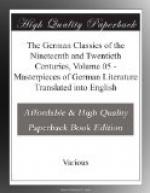For in the statues of the most perfect or divine natures not only all the complexity of form of which human nature is capable had to be united, but moreover the union must be such as may be conceived to exist in the system of the Universe itself—the lower forms, or those relating to inferior attributes, being comprehended under higher, and all at last under one supreme form, in which they indeed extinguish one another as separately existing, but still continue in Essence and efficiency.
Thus, though we cannot call this high and self-sufficing Beauty characteristic, so far as herewith is connected the notion of limitation or conditionality in the manifestation, yet still the characteristic continues efficient, though indistinguishable, within; as in the crystal, although transparent, the texture nevertheless remains; each characteristic element has its weight, however slight, and helps to bring about the sublime equipoise of Beauty.
The outer side or basis of all Beauty is beauty of form. But as Form cannot exist without Essence, wherever Form is, there also is Character, whether in visible presence or only perceptible in its effects. Characteristic Beauty, therefore, is Beauty in the root, from which alone Beauty can arise as the fruit. Essence may, indeed, outgrow Form, but even then the Characteristic remains as the still efficient groundwork of the Beautiful.
That most excellent critic,[6] to whom the gods have given sway over Nature as well as Art, compares the Characteristic in its relation to Beauty, with the skeleton in its relation to the living form. Were we to interpret this striking simile in our sense, we should say that the skeleton, in Nature, is not, as in our thought, detached from the living whole; that the firm and the yielding, the determining and the determined, mutually presuppose each other, and can exist only together; thus that the vitally Characteristic is already the whole form, the result of the action and reaction of bone and flesh, of Active and Passive. And although Art, like Nature, in its higher developments, thrusts inward the previously visible skeleton, yet the latter can never be opposed to Shape and Beauty, since it has always a determining share in the production of the one as well as of the other.
But whether that high and independent Beauty should be the only standard in Art, as it is the highest, seems to depend on the degree of fulness and extent that belongs to the particular Art.
Nature, in her wide circumference, ever exhibits the higher with the lower; creating in Man the godlike, she elaborates in all her other productions only its material and foundation, which must exist in order that in contrast with it the Essence as such may appear. And even in the higher world of Man the great mass serves again as the basis upon which the godlike that is preserved pure in the few, manifests itself in legislation, government, and the establishment of Religion. So that wherever Art works with more of the complexity of Nature, it may and must display, together with the highest measure of Beauty, also its groundwork and raw material, as it were, in distinct appropriate forms.




